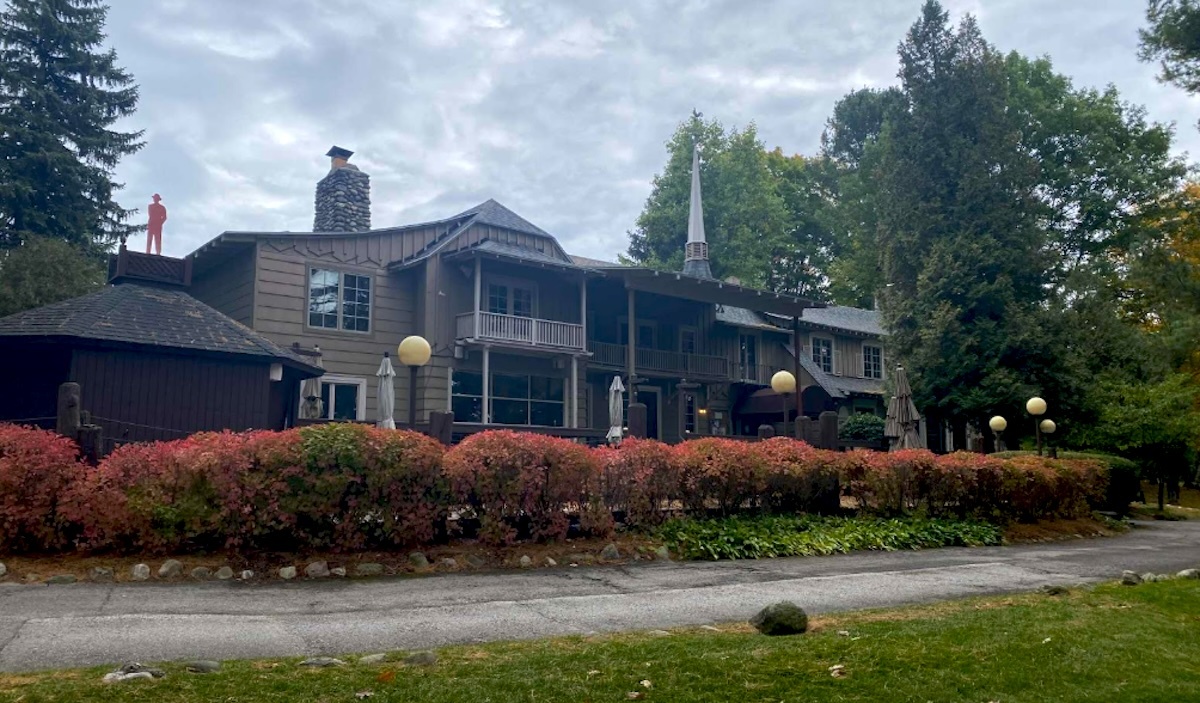
Would the Real Mrs. Stickney Please Stand Up? Setting the Old Mission Ghost Story Straight
A local historian on Jennie (not Genevieve) Stickney and the false tales surrounding the Bowers Harbor “ghost”
By Anna Faller | Oct. 25, 2025
If you’ve spent any time on Old Mission Peninsula, you’ve no doubt heard of “Genevieve” Stickney, whose sorrowful (and sometimes mischievous) spirit is said to haunt the picturesque estate that Mission Table, Jolly Pumpkin, and the Peninsula Room now occupy—formerly Bowers Harbor Inn and The Bowery.
But what if most, if not all of, that supernatural storytelling is verifiably incorrect? According to the extensive research of local historian and writer Julie Morris, the real history of the Stickneys’ lives is far more—well—natural.
“Theirs is not a story worthy of lore, but one of a couple who had many friends, were well-liked in the community, and who worked very hard to promote the well-being of the [local] fruit industry,” Morris says.
Let’s dive into fact and fiction of the Stickney legacy.
Myth: Mrs. Stickney’s Name was Genevieve
The simplest and most pervasive myth is a misnomer. Most Traverse Citians will tell you Mrs. Stickney’s name was Genevieve. As Morris counters, “it was never Genevieve,” but Jennie.
Per Morris’ research, Jennie Eveline Stickney (neé Worthen) was born in 1865 in Lebanon, New Hampshire to parents Evelyn and George W. Worthen—the latter, a successful dry-goods merchant. Though there isn’t much to be found about Jennie’s early life (an all-too common circumstance for women in the 19th century), we do know that she was one of six kids, that she attended the local school, and that her upbringing was likely typical for that of an upper-class child in New England.
We also know that the “Genevieve” moniker didn’t appear until the publication of Jennie’s death record. “If you look at any solid record prior to that”—from her birth and marriage certificates, to travel documents, down to the family Bible—“all the census records I can find, it’s always Jennie,” Morris says.
In fact, Morris adds, the misnomer is likely attributable to a clerical error, wherein the physician tasked with confirming Jennie’s death might have misheard or just assumed that Jennie was a nickname for something longer, like Genevieve.
“He probably knew her as ‘Mrs. Stickney,’ or might not have even known her name. I think that’s where it all started,” Morris says.
(By the way, referring to Mr. Stickney as “J.W.” is also incorrect. Records show that his real name was Charles, and that J.W. probably stems from a conflation of his wife, Jennie Worthen’s, initials.)
Myth: Mr. Stickney Was a Wealthy Lumber Baron
Though Mr. Stickney, aka, Charles Francis (b. 1868 in Groveland, MA) also came from relative wealth, it wasn’t the high-falutin steel and lumber riches local lore suggests.
“If [that were the case],” says Morris, “there would be many articles about him. But very little is found, so he was not the super-rich oligarch as legends would have you believe.”
Instead, he joined his family’s business, a successful shoe- and boot-manufacturing company, alongside his father, Charles E. Stickney, starting around the 1880s, through which he amassed the bulk of his wealth. Jennie also had her own money, perhaps inherited from her parents’ estates. (Fun fact: the couple’s Bower’s Harbor farm deed was in her name, not her husband’s!).
As such, there is some truth to the stories that suggest they were financially comfortable. So comfortable, in fact, that economic slumps, like World War I and the Great Depression, had little impact on their social lives, which included luxury travel and seasonal suites. They were also members of the Traverse City Country Club and were known to be active participants in their communities’ societal functions.
“By all accounts,” Morris notes, “they were well-connected with those in their standing, active in their community, and well-liked—at least by those they socialized with.”
Myth: The Stickney House Was Built in the 1880s
This brings us to their home at Bowers Harbor, which was not constructed in the 1880s. Heck—the Stickneys weren’t even married, let alone in Michigan, then!
Per Morris, the property’s first iteration was a farmhouse, which Jennie purchased from a local family, the Hartsons, in 1909. Here, she began a cottage business, crafting jams, brandies, and pies from the fruit Charles grew. Meanwhile, Charles co-founded a canning business in 1910 which operated for about 20 years, and both Stickneys used their social platforms to advocate for local farmers throughout the 1920s and 1930s.
“Charles [and Jennie] worked hard to help the farming community and those struggling to keep production going,” Morris says. “I don’t think that was well known, but it was very important to [them].”
In 1927, however, the farmhouse suffered a chimney fire, which the Stickneys, then in their early 60s, took as license to build their dream summer home, which would eventually serve as the site for the Bowers Harbor Inn.
To complete the project, Jennie enlisted the help of her nephew, Minnesota architect, Kenneth B. Worthen, and his partner, Percy Dwight Bentley, whose influence built on the farmhouse foundation to produce the sharp lines and whimsical details of today’s 1920s-inspired structure.
This is also when the home’s infamous elevator—likely a residential first for the region, notes Morris—went in, both as an eccentrically-Worthen detail, as well as a means for the Stickneys to avoid the stairs.
Myth: The Nurse, the Affair, and the Death of the Stickneys
By the mid-1940s, the Stickneys were both approaching 80 and in declining health. Jennie, in particular, was known to be heavy towards the end of her life (which likely provided fodder for the vanity and obesity elements of her legend) and struggled with multiple health concerns, including heart disease, diabetes, and possible dementia.
To mitigate some of these issues, the Stickneys hired a personal nurse, a widow Morris calls Kathryn J., who, accompanied by her two children, boarded with them for nearly four years as the pair’s full-time caretaker.
After Charles Stickney died, Kathryn also received the bulk of her employers’ estate—including the Bowers Harbor property, two cars, and the Stickneys’ stocks and insurance—in their will.
Per Morris, it was this generous gift, which Charles likely intended to provide long-term income for Kathryn and her kids, from which the cruel and historically baseless rumors of their affair arose.
“Some of the falsehoods that have been published are ridiculous,” Morris decries.
Equally as ludicrous is Jennie’s supposed scorned-woman suicide-by-elevator. The real story is far more commonplace, wherein she passed at the Pantlind Hotel in Grand Rapids in 1947, likely of cardiovascular failure. Notably, she died before her husband, so she would never have known about the house being left to Kathryn.
Fact vs. Fiction
As for why this Stickney urban legend became so popular? We can only speculate.
Per Morris, some of the property’s earliest ghost stories go back to a Record-Eagle article published on Halloween 1977, which is also probably where the J.W. and Genevieve Stickney names arose, she notes.
The motivations behind these tales remain largely unclear. We know that the Stickneys were of prominent social standing and managed to maintain their wealth through periods of economic turmoil. Could they have been power-hungry or spurned the working class, sparking local contempt, Morris wonders? Perhaps their status as seasonal residents demeaned them in the eyes of their neighbors. Or it could be that all the details just got mixed up and the fantasy was more fun than the facts.
“Sadly, this spiteful gossip became the local legend of the Stickneys,” Morris says. “[It] is not based in truth and has resulted in tarnishing the Stickneys’ reputations to this day.”
This brings us to a related question: If none of the vanity, infidelity, or suicide rumors surrounding Jennie are true, what reason would she have to be sticking around the Bowers Harbor Inn grounds? Staff who have worked in the various businesses have long told tales of strange happenings and ghostly encounters.
As Morris suggests, maybe Jennie loved her home so much, she just isn’t ready to leave. Maybe she feels she can’t rest because so many untruths continue to circulate.
Or maybe there’s a resident ghost that belongs to someone other than Jennie.
Three members of the Hartson family all died in the original farmhouse, for instance, parts of which are still intact. If dying on the premises is a “prerequisite for haunting,” Morris says, couldn’t the unexplained activity just as easily be one of them? Nurse Kathryn’s daughter also noted a “strange” feeling in the house while Stickneys were there, Morris adds, suggesting that a haunting might have been underway before they passed.
Nevertheless, the fables of the Stickneys persist, both in local memory and on the Peninsula Room and Mission Table websites. (No one from the Mission Restaurant Group, which runs the on-site restaurants, responded to multiple attempts to contact them for this story.)
By working to dispel the myths, Morris hopes we can not only attribute fresh perspective to a historic and truly one-of-a-kind building, but restore the reputation and legacy of a woman who’s no longer alive to defend it.
Perhaps when we do, Morris adds, Jennie’s “ghost” can finally get some rest.
Trending

Freshwater Summit in Traverse City
Bioregionalism, sea lamprey control, and environmental DNA are just a few topics of the 18th annual Freshwater Summit, where… Read More >>
Interlochen Presents 'The Laramie Project'
In October of 1998, college student Matthew Shepard was beaten and left to die near Laramie, Wisconsin. His death eventually… Read More >>
Howling at the Moon
Your Halloween costume needs one final touch…and Northern Nail Polish has you covered. This Traverse City-based brand… Read More >>


